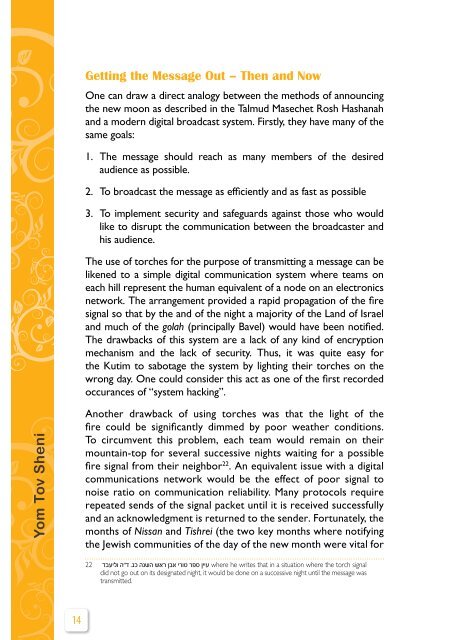Y om T o v Sheni Yom Tov Sheni - Chidushei Torah@NDS
Y om T o v Sheni Yom Tov Sheni - Chidushei Torah@NDS
Y om T o v Sheni Yom Tov Sheni - Chidushei Torah@NDS
You also want an ePaper? Increase the reach of your titles
YUMPU automatically turns print PDFs into web optimized ePapers that Google loves.
Y<strong>om</strong> <strong>Tov</strong> <strong>Sheni</strong><br />
14<br />
Getting the Message Out – Then and Now<br />
One can draw a direct analogy between the methods of announcing<br />
the new moon as described in the Talmud Masechet Rosh Hashanah<br />
and a modern digital broadcast system. Firstly, they have many of the<br />
same goals:<br />
1. The message should reach as many members of the desired<br />
audience as possible.<br />
2.<br />
To broadcast the message as efficiently and as fast as possible<br />
3. To implement security and safeguards against those who would<br />
like to disrupt the c<strong>om</strong>munication between the broadcaster and<br />
his audience.<br />
The use of torches for the purpose of transmitting a message can be<br />
likened to a simple digital c<strong>om</strong>munication system where teams on<br />
each hill represent the human equivalent of a node on an electronics<br />
network. The arrangement provided a rapid propagation of the fire<br />
signal so that by the and of the night a majority of the Land of Israel<br />
and much of the golah (principally Bavel) would have been notified.<br />
The drawbacks of this system are a lack of any kind of encryption<br />
mechanism and the lack of security. Thus, it was quite easy for<br />
the Kutim to sabotage the system by lighting their torches on the<br />
wrong day. One could consider this act as one of the first recorded<br />
occurances of “system hacking”.<br />
Another drawback of using torches was that the light of the<br />
fire could be significantly dimmed by poor weather conditions.<br />
To circumvent this problem, each team would remain on their<br />
mountain-top for several successive nights waiting for a possible<br />
fire signal fr<strong>om</strong> their neighbor 22 . An equivalent issue with a digital<br />
c<strong>om</strong>munications network would be the effect of poor signal to<br />
noise ratio on c<strong>om</strong>munication reliability. Many protocols require<br />
repeated sends of the signal packet until it is received successfully<br />
and an acknowledgment is returned to the sender. Fortunately, the<br />
months of Nissan and Tishrei (the two key months where notifying<br />
the Jewish c<strong>om</strong>munities of the day of the new month were vital for<br />
22 דבעילו ה”ד .גכ הנשה שאר ןבא ירוט רפס ןייע where he writes that in a situation where the torch signal<br />
did not go out on its designated night, it would be done on a successive night until the message was<br />
transmitted.


